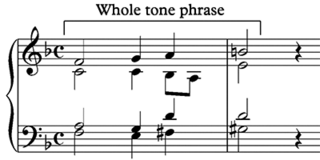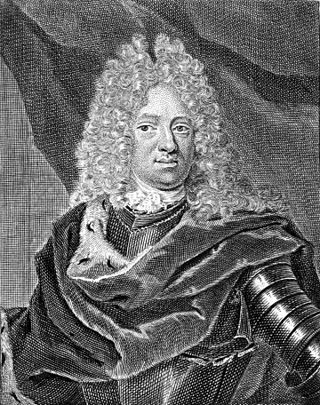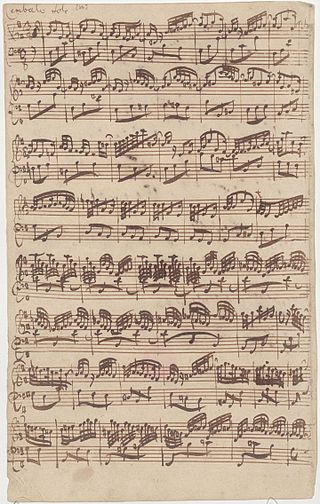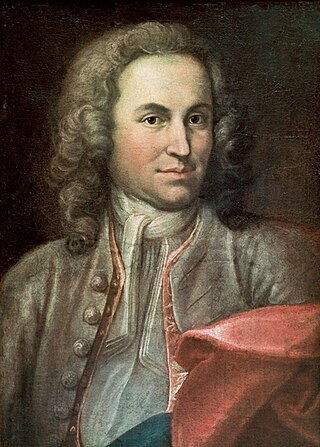Related Research Articles

Johann Sebastian Bach composed the church cantata Herz und Mund und Tat und Leben, BWV 147 in 1723 during his first year as Thomaskantor, the director of church music in Leipzig. His cantata is part of his first cantata cycle there and was written for the Marian feast of the Visitation on 2 July, which commemorates Mary's visit to Elizabeth as narrated in the Gospel of Luke in the prescribed reading for the feast day. Bach based the music on his earlier cantata BWV 147a, written originally in Weimar in 1716 for Advent. He expanded the Advent cantata in six movements to ten movements in two parts in the new work. While the text of the Advent cantata was written by the Weimar court poet Salomo Franck, the librettist of the adapted version who added several recitatives is anonymous.

Johann Sebastian Bach composed the secular cantata Die Zeit, die Tag und Jahre macht, BWV 134.1, BWV 134a, while he was in the service of the court of Leopold, Prince of Anhalt-Köthen. Bach wrote the work as a serenata for the celebration of New Year's Day 1719.

Johann Sebastian Bach composed the church cantata Komm, du süße Todesstunde, BWV 161, in Weimar for the 16th Sunday after Trinity, probably first performed on 27 September 1716.

O Ewigkeit, du Donnerwort, BWV 60, is a church cantata for the 24th Sunday after Trinity composed by Johann Sebastian Bach. It was first performed in Leipzig on 7 November 1723, and is part of Bach's first cantata cycle. It is one of Bach's dialogue cantatas: its topic, fear of death and hope of salvation, plays out mainly through a conversation between two allegorical figures, Fear and Hope.

O angenehme Melodei, BWV 210.1, is a secular cantata by Johann Sebastian Bach for a solo soprano. Bach wrote it in Leipzig as a "Huldigungskantate" for Christian, Duke of Saxe-Weissenfels. First performed on 12 January 1729, the cantata became part of his repertory of congratulatory and homage cantatas, dedicated at least twice to different people and occasions. Bach used it as the base for his wedding cantata O holder Tag, erwünschte Zeit. Most of the music of O angenehme Melodei was lost, but can be reconstructed from the later work, which survived completely.
Amore traditore, BWV 203, is a secular cantata composed by Johann Sebastian Bach in Köthen between 1718 and 1719, while he was in the service of the court of Leopold, Prince of Anhalt-Köthen. Bach wrote the unusual work on an Italian libretto for a bass soloist and harpsichord.

Herz und Mund und Tat und Leben, BWV 147.1, BWV 147a, is a cantata by Johann Sebastian Bach. He composed it in Weimar in 1716 for the fourth Sunday in Advent, 20 December. It is uncertain if the work was performed then. He later expanded the work in 1723 as Herz und Mund und Tat und Leben, BWV 147.

Partita for keyboard No. 4 in D Major, BWV 828, is a keyboard suite by Johann Sebastian Bach, originally dated 1728. It is the fourth suite in his Clavier-Übung I.

The Partita for keyboard No. 6 in E minor, BWV 830, is a suite of seven movements written for the harpsichord by Johann Sebastian Bach. It was published in 1731 both as a separate work and as part of Bach's Clavier-Übung I.
Performances of Johann Sebastian Bach's Magnificat come in three formats:
- D major version, BWV 243 with the twelve movements of that version;
- D major version, with the Christmas interpolations from the earlier version BWV 243a transposed and inserted after movements 2, 5, 7 and 9.
- E flat major version, BWV 243a. The difference with the previous format is not only the key signature, there are also differences in orchestration, e.g. in the earlier version flutes are not part of the tutti, so do not play in the choral movements 1, 7 and 12, and a trumpet solo in movement 10 instead of the later unison oboes. Other differences are minor, but there is for instance a slightly harsher harmony near the end of movement 4 in the earlier version.

Johann Sebastian Bach started composing cantatas around 1707, when he was still an organist in Arnstadt. The first documented performances of his work took place in Mühlhausen, where he was appointed in 1708.
Johann Sebastian Bach worked at the ducal court in Weimar from 1708 to 1717. The composition of cantatas for the Schlosskirche on a regular monthly basis started with his promotion to Konzertmeister in March 1714.

"Dies sind die heilgen zehn Gebot" is a hymn by the Protestant reformer Martin Luther based on the Ten Commandments. It appeared first in 1524 in the Erfurt Enchiridion.

Prelude and Fugue in B minor, BWV 544 is a piece of organ music written by Johann Sebastian Bach sometime between 1727 and 1731, during his tenure in Leipzig. Unlike most other organ preludes and fugues of Bach, the autograph fair copy of the score survives.

Prelude and Fugue in C minor, BWV 546 is a piece of organ music written by Johann Sebastian Bach, with the prelude dating around his time in Leipzig (1723–1750), and the fugue dating around his time in Weimar (1708–1717). Like most other organ prelude and fugues of Bach, no autograph score survives, with the oldest known score copied by Johann Peter Kellner, an acquaintance of Bach. The work was played as a postlude for the funeral of Diana, Princess of Wales, the funeral of Prince Philip, Duke of Edinburgh, and the Committal of Queen Elizabeth II by organists Martin Neary and Luke Bond, respectively.

Daniel Vetter was an organist and composer of the German Baroque era.

The Partita for keyboard No. 2 in C minor, BWV 826, is a suite of six movements written for the harpsichord by Johann Sebastian Bach. It was announced in 1727, issued individually, and then published as Bach's Clavier-Übung I in 1731.
References
- 1 2 Author information, Oxford University Press, Canada
- 1 2 3 Contributors to Understanding Bach. Bach Network UK. Retrieved 24 January 2015.
- ↑ Ledbetter, David (2007). "Early Bach / The Creative Development of Johann Sebastian Bach. Volume I: 1695-1717. Music to Delight the Spirit by Richard D. P. Jones". Early Music. 35 (4): 634–635. doi:10.1093/em/cam101. JSTOR 30139527.
- ↑ Smaill, Peter (2014). Book review / The Creative Development of Johann Sebastian Bach / Volume II: 1717-1750 (PDF). The Journal of the London Bach Society . Retrieved 24 January 2015.